Potential strategies to reduce the impact of waterlogging on crop yields
Potential strategies to reduce the impact of waterlogging on crop yields
Author: Malcolm McCaskill (Agriculture Victoria Research, Hamilton, Victoria) and Roger Armstrong (Agriculture Victoria Research, Horsham, Victoria) | Date: 24 Feb 2022
Take home messages
- Tactical options including early sowing, early application of nutrients (preferably using enhanced fertiliser forms) or aerial application after waterlogging can improve yields and fertiliser use efficiency.
- Faba bean and wheat are relatively tolerant of waterlogging beyond the juvenile stage whereas canola appears highly sensitive at all growth stages.
- The impact of waterlogging on crop yields is often highly variable within a paddock, requiring spatially explicit management responses.
- Nitrogen requirements in parts of the paddock exposed to prolonged waterlogging are higher than in well-drained areas because of poorer crop utilisation and greater N losses (presumably via denitrification).
When and where does waterlogging occur
Short-term perched water tables occur in most years in the High Rainfall Zone (HRZ), but the depth and duration of perched water tables is rarely measured. In a study of paddock variability conducted in 2021, the water table was within 10cm of the surface between mid-July and mid-August and included some periods when almost the entire paddock had water above the soil surface (Figure 1). Over the longer term, soil moisture data from a cropping paddock near Hamilton shows that full soil moisture profiles occur in most years between mid-July and mid-September, but may start as early as May and finish as late as mid-October in some years. Ironically, in some seasons, water shortages during grain filling in these paddocks can subsequently reduce a crop’s ability to achieve expected yield potentials.
Waterlogging is not only a problem in the high rainfall zone. At three Wimmera (medium rainfall zone) paddocks monitored in 2021, periods of high water tables were recorded between mid-July and mid-August, with a brief period of a high water table at one site in October following a storm (Figure 3). These perched water tables occurred despite the deeper soil layers not fully wetting due to constrained water movement into sodic (dispersive) clay subsoils.
What changes occur under waterlogging?
While the most obvious change under waterlogging is loss of trafficability for spraying and fertilising operations, plant roots and microbes suffer shortage of oxygen (anoxia). Plant roots need oxygen to provide the energy to take up nutrients such as nitrate, which are at low concentrations in the soil water but are required at much higher concentrations within the plant. Respiration from plant roots and microbes cause the soil to rapidly become anoxic in waterlogged soil, which curtails most aerobic respiration. The nodal roots of wheat have air-conducting spaces known as aerenchyma that allow oxygen to move within the root to a soil depth of about 10cm, enabling the crop to grow and access nutrients from this layer. However, until the tillering stage, wheat plants are dependent on their seminal roots, which lack aerenchyma, for water and nutrient uptake. These roots stop growing soon after waterlogging and have limited capacity to regrow after waterlogging ceases. Severe waterlogging at this stage can lead to plant death. Faba beans have an air-filled hollow in the stem that continues into the larger roots, and appears to be capable of rhizobia nodules with oxygen. Nevertheless, faba beans are at risk of plant death if waterlogging occurs early in the plant’s life.
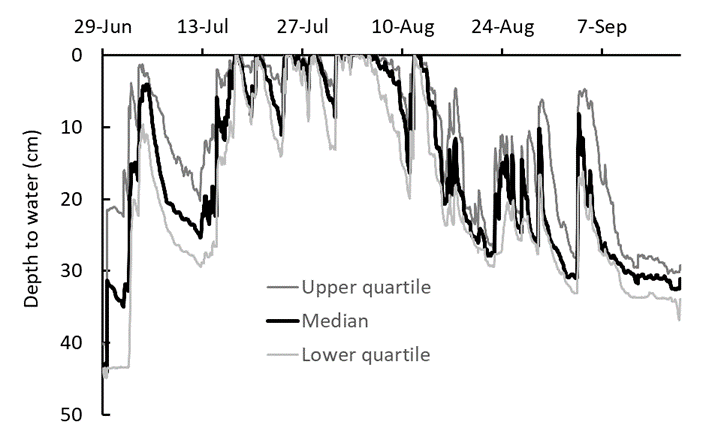
Figure 1. Depth to the perched water table at 12 monitoring positions within a paddock at Wickliffe in the HRZ during 2021.
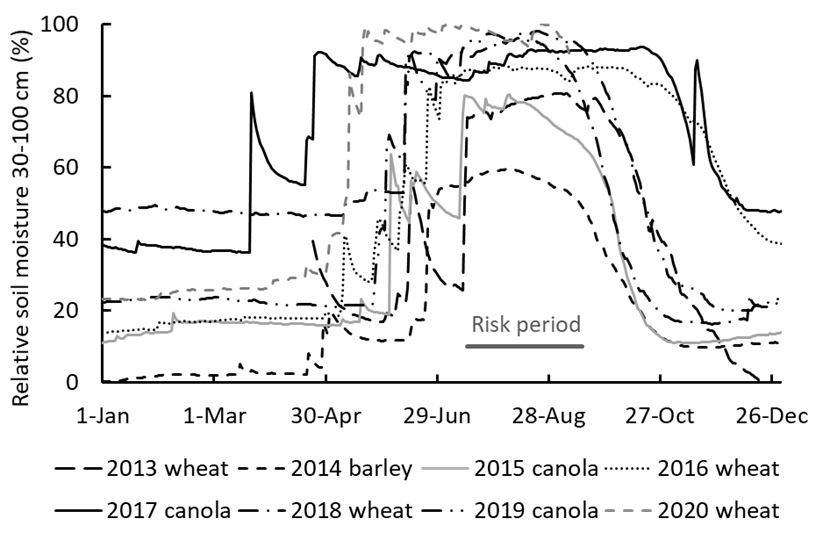
Figure 2. Seasonal changes in soil moisture in a cropping paddock near Hamilton over 8 seasons, indicating the high-risk period for waterlogging between mid-July and mid-September. Source: Agriculture Victoria soil moisture monitoring network.
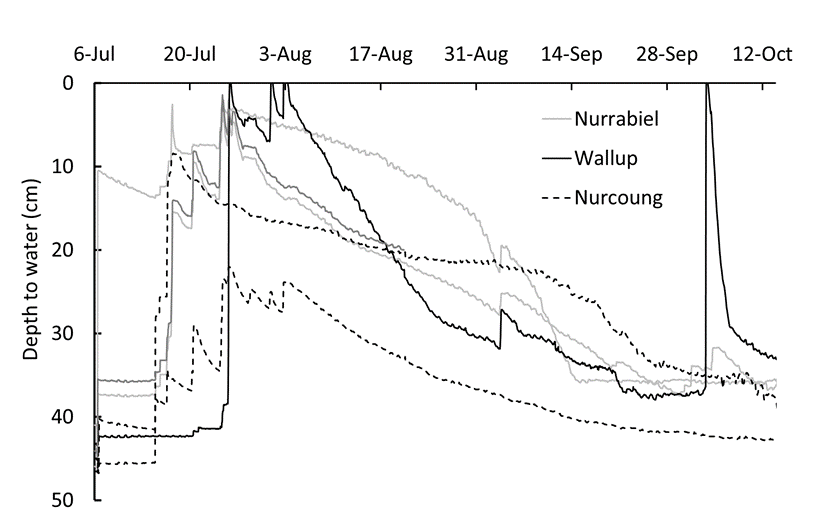
Figure 3. Depth to a perched water table in three paddocks in the Wimmera in 2021 – Nurrabiel (2 monitoring positions), Wallup (1 position) and Nurcoung (2 positions).
Canola lacks adventitious roots and in saturated soil is entirely dependent on a thin oxidised layer of soil near the surface for its nutrient uptake. In one nutrient response experiment in 2016, we measured large responses to broadcast urea and potash despite soil tests indicating adequate quantities of plant available N and K in the soil profile (Figure 4). Raised beds provided a layer of aerated soil 5-10cm deep, below which root access was restricted due to waterlogging. This experiment shows that high canola yields are possible under prolonged waterlogging if sufficient nutrition is provided in the surface layers.
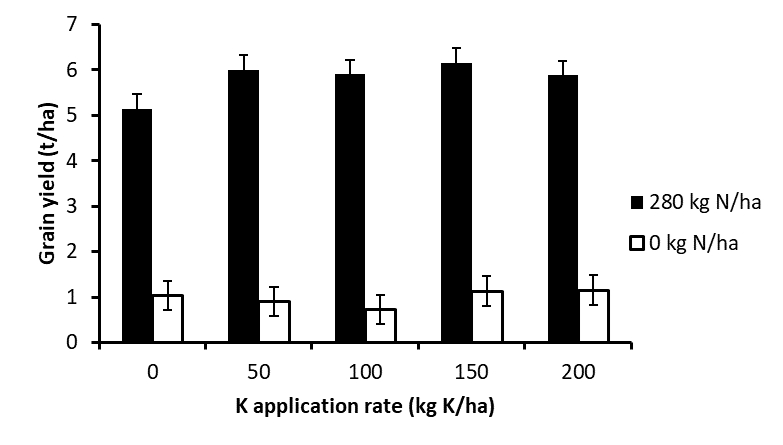
Figure 4. Response of canola to top-dressed urea and potash at Hamilton in 2016 on a site with 160mg/kg of Colwell-extractable K in the top 10cm, and 238kg/ha of KCl extractable nitrate-N in the top 60cm. Error bars indicate the 5% Lsd. Source: McCaskill et al. (2020).
Measures to reduce this risk of nutrient deficiency include strategies that help the crop avoid waterlogging during critical growth stages by early sowing, applying N ahead of peak plant demand, particularly immediately prior to periods of high waterlogging risk, and aerial application of urea if necessary. The nitrification inhibitor ENTEC® has been shown to reduce N losses if applied well ahead of demand at times of high waterlogging risk (Harris et al. 2016). Potassium deficiency also needs to be assessed prior to sowing. The critical soil test value for Colwell-extractable K in the topsoil should be higher for crops at risk of prolonged waterlogging (273mg K/kg) than for crops where this risk is lower (73mg K/kg) (McCaskill et al. 2020).
Under saturated soil conditions, soil microbes change from aerobic respiration (using oxygen) to anaerobic respiration that metabolises nitrate into nitrous oxide and nitrogen gas, a process known as denitrification. Poorly drained areas therefore have higher rates of denitrification. In a 15N tracer study at Wickliffe in the HRZ, we found a higher proportion of the fertiliser N applied being unaccounted for at harvest (most of which is likely to have been denitrified) in a low-lying part of the paddock (Table 1). In the following season, low crop vigour in these poorly-drained areas became evident as areas of low NDVI on satellite images. Correcting these areas of low NDVI requires either a higher rate of N over the entire paddock, or variable rate spreading.
Table 1: Percentage of 15N labelled urea (100kg/ha, applied at GS30) recovered in the wheat grain, stubble, soil and unaccounted for, presumed mostly denitrified.
Lower slope | Mid-slope | Upper | 5% Lsd | |
|---|---|---|---|---|
15N in grain (%) | 15a | 38b | 41b | 6 |
15N in stubble (%) | 3a | 7b | 8b | 2 |
15N in soil (%) | 23 | 26 | 25 | 12 (ns) |
15N unaccounted for (%) | 59b | 29a | 26a | 13 |
What is the yield penalty due to waterlogging?
Wheat yields in areas prone to waterlogging can be as much as 38% below that of well-drained areas. The size of yield loss varies substantially in time and space, so crop simulation modelling could be a useful tool to estimate losses. However, models such as APSIM currently do not yet have the capability to estimate yield loss from waterlogging. As a first step in improving model performance in waterlogged conditions, we conducted detailed measurements of wheat and faba bean crops in an experiment at Hamilton in which waterlogging was imposed through frequent irrigation for a short (17 days) or a long period (30 days) during flowering. Although there were significant effects on crop biomass (Figure 5), we only measured significant yield differences in wheat (38%), but not faba bean (Table 2). The non-waterlogged faba beans, however, were taller and suffered more severe lodging during a storm than the waterlogged treatments. Early differences in biomass may therefore not translate into increased grain yield.
Figure 5. Above ground biomass accumulation in wheat and faba bean crops, showing the period when irrigation was imposed to create short (17 days) and long (30 days) durations of waterlogging. Error bars show the 5% Lsd and asterisks when differences were significant.
Table 2: Grain yield of wheat and canola crops exposed to short and long periods of waterlogging during flowering.
Non-waterlogged | Short | Long | Lsd 5% | |
|---|---|---|---|---|
Wheat (t/ha) | 8.4 b | 6.8 ab | 5.2 a | 1.8 |
Faba bean | 8.7 a | 8.9 a | 7.5 a | 3.3 |
Self-sown crops
In some years in the HRZ, substantial falls of rain are experienced in November and December when the crop is maturing and unable to effectively utilise this soil moisture. Our field trials have shown that moisture above about 30cm is lost to soil evaporation and transpired by self-sown plants over the summer fallow period, whereas deeper soil water remains until sowing of the following winter crop, greatly increasing the risk of waterlogging. A summer dewatering crop in such years could create a buffer of dry soil that would delay the onset of saturated soil conditions for the following winter crop, so the plants are larger and better able to tolerate waterlogging. One such year was 2020. In a paddock sown to canola, the soil was moist at the time of windrowing, and the soil profile contained 94mm more water in the soil profile than when the previous crop of wheat was harvested (Figure 6). To utilise carryover soil moisture, self-sown canola was allowed to grow. However, it was unable to dry the deeper layers of the soil and did little more than utilise most of the 200mm of summer rain that fell over the fallow period. During soil coring in the paddock, we encountered a hard dry layer at about 30cm depth, below which penetration was easy. Since plant roots would have similar difficulties penetrating this layer, it may be necessary to establish plants early in the summer period before this layer dries through soil evaporation.
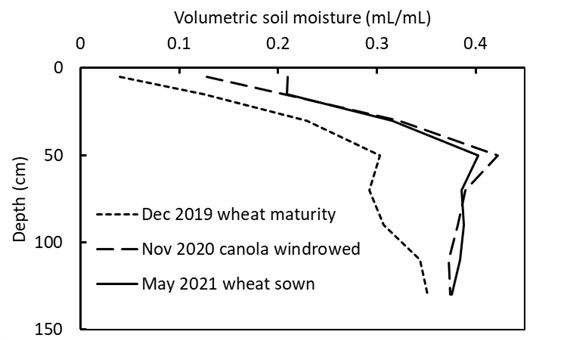
Figure 6. Soil moisture at wheat maturity in 2019, when canola was windrowed in November 2020, and when the following crop of wheat was sown in 2021. Data are averaged across 40 monitoring points.
Drainage and lucerne understorey
In Victoria, few growers have installed underground drainage for field crops. Some growers in the Cavendish area have installed underground drains on their cropping paddocks and used this in combination with an understorey of lucerne as a dewatering crop. Drainage installation costs were estimated at $1250/ha in 2016, and a 38% rate of return was calculated based on higher wheat and canola yields, and lamb finishing on lucerne during the summer (Lewis and Price 2016). Alternatively, one grower who implemented subsoil manuring reported that paddocks that previously could only grow pasture were now producing wheat yields of up to 10t/ha.
Conclusion
Wheat and faba bean are vulnerable to waterlogging early in the crop life, but in most years, have developed their nodal roots by the time waterlogging commences. These crops are subsequently relatively robust if the soil is saturated. Canola lacks roots that conduct oxygen, but nevertheless can produce good yields if sufficient nutrition is supplied into the aerated surface layers during periods of waterlogging.
Acknowledgements
The research undertaken as part of these projects is made possible by the significant contributions of growers through both trial cooperation and the support of the GRDC and the Victorian Government, and the authors would like to thank them for their continued support.
We thank Dr. Fiona Robertson for providing the initial leadership of the Waterlogging Modelling project (VGIP2C), and Darren Keane, Reto Zollinger and John Byron for their technical assistance.
References
Harris RH, Armstrong RD, Wallace AJ, Belyaeva ON (2016) Delaying nitrogen fertiliser application improves wheat 15N recovery from high rainfall cropping soils in south eastern Australia. Nutrient Cycling in Agroecosystems 106(1), 113-128.
Lewis B, Price D (2016) Managing wet areas. “Proceedings of the 57th Annual Conference, Grasslands Society of Southern Australia ‘Ready, Set, Grow!’. Hamilton, Victoria”, 31 August–1 September 2016, pp 27-29.
McCaskill MR, Riffkin P, Pearce A, Christy B, Norton R, Speirs A, Clough A, Midwood J, Merry A, Suraweera D, Partington D (2020) Soil-test critical values for wheat (Triticum aestivum) and canola (Brassica napus) in the high-rainfall cropping zone of southern Australia. Crop and Pasture Science 71(12), 959–975.
Contact details
Malcolm McCaskill
Agriculture Victoria Research
915 Mt Napier Rd, Hamilton VIC 3300
0407 850 671
Malcolm.mccaskill@agriculture.vic.gov.au
GRDC Project Code: DAV1403-001RTX, DAV1607-004BLX,

